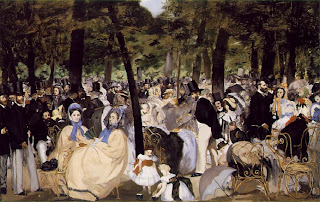The
Metropolitan Museum of Art reflects the global scopes of
collections and extends across the world through a variety
exhibitions, excavations, professional exchanges, conservation
projects, and traveling works of art. The Metropolitan Museum of
Art's roots date back to 1866 in Paris, France, when a group of
Americans agreed to create a "national institution and gallery
of art" to bring art and art education to the American people.
In 1938 the museum extended with a new building called the Cloisters
museum and gardens. This branch focus' on the art and architecture of
medieval Europe. When I visited the Metropolitan Museum of Art, I
looked at paintings from several artists including Edgar Degas,
Pierre-Auguste Renoir, Georges Braque, Edward Hopper, Grant Wood,
Pablo Picasso and my personal favorite Salvador Dali. My favorite
section of the museum was the Modern and Contemporary Art wing of the
museum. The first artist I viewed was Edgar Degas and his sculpture
“The Fourteen Year old Dancer”, it was very different in person
than what I saw online. My favorite artist that I visited was
Salvadore Dali. My favorite was “Madonna” which was painted in
1958 as an oil painting on canvas. It is Dali's rendition of Raphaels
Sistine Madonna reference to the Passion of Christ.
Monday, February 20, 2012
Thursday, February 9, 2012
Artist from 1910-1950
Salvatore Dali is best known for the
striking and bizarre images in his surrealist work. His best-known
work, The Persistence of Memory, was completed in 1931. Salvatore
Dalí's expansive artistic collection includes film, sculpture, and
photography. The Basket of Bread, painted in 1926, is a painting that
depicts four pieces of bread with butter on them sitting in a basket.
The painting resides at the Salvador Dali Museum, St. Petersburg, Fl.
Diego Rivera began drawing when he was only
three, just a year after his twin brother's death. He had been caught
drawing on the walls. His parents, installed chalkboards and canvas
on the walls for him to make use. The kid, painted by Diego Rivera is
one of my favorite pieces by him, next to the skeleton is Frida Kahlo, his wife,
and himself in the painting.
Frida Kahlo is best known for her
self-portraits. She once said, "I paint myself because I am so
often alone and because I am the subject I know best." Frida
Kahlo's work is remembered for its "pain and passion", and
its intense, vibrant colors. Her work has been celebrated in Mexico
as emblematic of national and indigenous tradition, and by feminists
for its uncompromising depiction of the female experience and form. I
enjoy her piece “The Suicide of Dorothy Hale” which is an oil
painting from 1939. It is on display at the Phoenix Art Museum in
Phoenix Arizona.
Wednesday, February 1, 2012
Artists from Impressionism
In class we learned about several different artists who were known to be the original artists for Impressionism. The impressionist style of painting is characterized by concentration on the general impression produced by a scene or object and the use of unmixed primary colors and small strokes to simulate actual reflected light. The principal Impressionist painters were Claude Monet, Pierre Auguste Renoir, Édouard Manet, and Edward Degas.
Édouard Manet, lived 1832-1883, was a French painter. One of the first 19th-century artists to approach modern-life subjects. His early works, The Luncheon on the Grass and Olympia, caused great controversy and served as a principle for young painters who would create Impressionism. Today, these are considered watershed paintings that mark the genesis of modern art. Music in the Tuileries is an early example of Manet's painterly style, it is said to be inspired by his life-long interest in leisure. While the picture was regarded as unfinished by some, the suggested atmosphere imparts a sense of what the Tuileries gardens were like at the time.
Here, Manet has depicted his friends, artists, authors, and musicians who take part, and he has included a self-portrait among the subjects:
Edgar Degas, born Hilaire-Germain-Edgar De Gas in 1834. Degas was a French artist famous for his work in painting, sculpture, printmaking and drawing. Degas is known to differ from the Impressionists in that he "never adopted the Impressionist color fleck", and he belittled their practice of painting “en plein air”. Degas explained, "no art was ever less spontaneous than mine. What I do is the result of reflection and of the study of the great masters; of inspiration, spontaneity, temperament, I know nothing."
"Little
Dancer of Fourteen Years" is a sculpture by Edgar Degas, in 1881
of a young dance student named Marie van Goethem. The sculpture was
originally made in wax before it was cast in 1922 in bronze. It is
built from wax, an unusual choice of material for a sculpture of this
time, dressed in a cotton skirt with a hair ribbon, sitting on a
wooden base.
Pierre-Auguste Renoir was a French artist from 1841 to 1919, who was a leading painter in the development of the Impressionist style. I found his oil painting, Mme. Charpentier and her children, one of my favorite paintings of his because I felt it showed a sense of closeness between Mme Charpentier and her daughters. Mme. Charpentier and her children was an oil painting on canvas painted in 1878. It is currently on display in the Metropolitan Museum of Art.
Subscribe to:
Comments (Atom)






